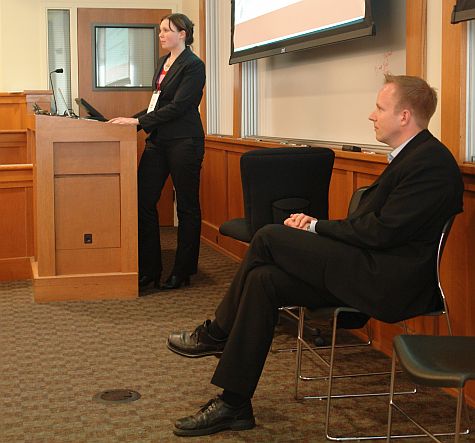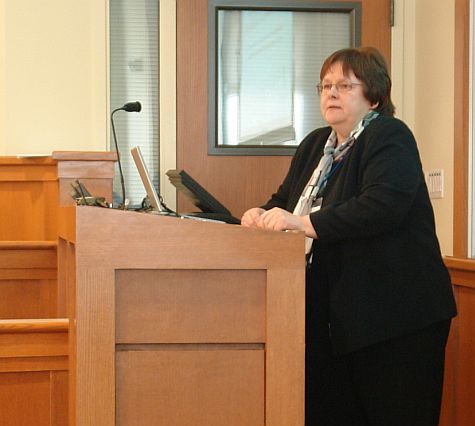This digest was created in real-time during the meeting, based on the speaker's presentation(s) and comments from the audience. The content should not be viewed as an official transcript of the meeting, but only as an interpretation by a single individual. Lapses, grammatical errors, and typing mistakes may not have been corrected. Questions about content should be directed to the originator. The digest has been made available for purposes of scholarship, posted on the Coevolving Innovations web site by David Ing.
Discussant: Marja Toivonen
Papers
- “Hybrid Innovation Management – Lessons Learned from Mobile TV Development”, by Kirsimarja Blomqvist, Kaisa Henttonen, Pia Hurmelinna-Laukkanen, and Paavo Ritala
- “Creating and Managing Hybrid Innovations”, by Shankar, Berry, and Dotzel
- “New Product Creation Process of KIBS Firms: A Case Study”, by Salmi, Torkkeli, Ojanen, and Hilmola
- “Innovation Processes In Professional Business Service Firms: Their Drivers, Nature And Management Challenges”, by Marja Toivonen and Anssi Smedlund
“Hybrid Innovation Management – Lessons Learned from Mobile TV Development”, by Kirsimarja Blomqvist, Kaisa Henttonen, Pia Hurmelinna-Laukkanen, and Paavo Ritala

Kirsimarja and Paavo
Lappeenranta
Hybrid has a different meaning
Mobile tv markets
- Finns are good in technology, but what about services?
Hybrid as multiple forces, e.g. competition-collaboration
Singapore and Italy have mobile tv ahead, e.g. Italy as 400,000 subscribers, ahead of Finland
- DVD-H technology, low battery consumption and faster than 3G
- Consumers want to watch, but also want to be interactive, e.g. voting, video blogs
Includes Nokia, carriers, broadcasters
- Forum Virium Helsinki, uses open innovation paradigm
Turning point
Contradictions and paradoxes
- Sequencing: one extreme at a time, e.g. R&D, then marketing
- Layering: have to rise above, picturing the whole market perspective
- Taking a third perspective: bring in a third party
Old boys network on technology development
- Bonding
- Need to bridging to build social capitals
- Also link
Project manager can act as boundary spanners
Technology-based service development plus service development as a new capability
Have to find new networks
- In Finland, can use trust, as don't have governance
[Questions]
Lobbying?
Legislation is falling behind
- Forgot to invite people to work out IPR, a mistake
“Creating and Managing Hybrid Innovations”, by Shankar, Berry, and Dotzel

Hybrid as combination of product and service innovations
Quotation from Embarq, spun off from Sprint: "bundled package of products and services"
Examples:
- Tivo, the digital video recorder, plus controlled live tv
- Xerox: copier, printer, supplies, plus maintenance, configuration and user support
Definition of hybrid innovation
- Utility of purchasing and consuming goods and services increase with each other
- Firm sells both
- Good and service are combined in a way unique to the firm
- Not tying in, so don't violate Sherman Act
Good-Service Continuum
- Goods dominant ... to services dominant
- Balanced: contract IT
Economics
- Three zones
- Dead zone, when price is below total unit cost, when scaling up
- Likely sweet spot zone: price about cost
- Nirvana zone: making so much money
For a service innovation ...
- Dead zone is shorter
- Likely sweet spot zone longer but thinner
- In the Nirvana zone, don't make as much profit
If combine product and service, may be able to get a better curve
Dimensions:
- Degree of complementary: Combining good and service to improve utility
- Degree of independence: Extent of availability
Taxonomy
| High complementarity | Low complementarity | |
| High independence | Flexible combo | Controllable bundle |
| Low independence | Twin Gain | Forced bundling |
Have studied 50 hybrid innovations, found success drivers
- Greater degree of commoditization, the higher the value of hybrid
- Solution centricity
- Revenue and profit potential
- Scalability, how long can you prolong
- Importance of branding
- Order of customer choice, whether customer chooses good or service first, e.g. cell phone North America picks service first, Europe picks product first
[Questions]
Like curves. Fixed or variable costs?
- That was for typical innovation, across 50 innovations
“New Product Creation Process of KIBS Firms: A Case Study”, by Pekka Salmi, Marko Torkkeli, Ville Ojanen, and Olli-Pekka Hilmola

Marko, Saari
Lappeenranta University of Technology
Research in 2004 and 2006, developed framework for multimedia and technology
- Focus on processes
Productization, bringing more tangible features to services
- Advantages
Few scholarly works
- Gronroos 2003 introduced a process model
- Vaattovaara 1999 model, based on case studies in an engineering consulting company
Concept of a service package
- Standard part
- Optional modules
- Customized parts
Case: Aptual Ltd., small KIBS firm specializing in Internet communications, founded in 2000, employs 7 people
- Core: Jalusta technology, helps company to design new web pages
Productization process
- 1. Determine the starting point, what does the customer need? What technology core?
- 2. Define the service package: standard part, module 1, module 2, integrated communication service
- 3. Development of the service package: build features, develop expertise
Conclusions:
- Need a clearly-defined service package
- Can reuse knowledge on an ongoing basis
[Questions]
Choice of firm?
- Started working with company 4 years ago, natural approach, constructive approach where company had a problem and we had theory
- Happy that company hasn't gone into bankrupcy
“Innovation Processes In Professional Business Service Firms: Their Drivers, Nature And Management Challenges”, by Marja Toivonen and Anssi Smedlund

Innovation Management Institute, Helsinki University of Technology
Also KIBS research, but use "professional services" phrase that is more common in the U.S.
Have selected professional business services firms, because they tend to be at the edge of innovation
- Clarification of the concept of service innovation, applying the Schumpeterian perspective
- Multiple case studies
Service innovation have had limitied definition, Schumpeter had a broad view that helps
- 5 types of innovation
- Helpful, except that can't separate out products and processes, since a service product constitutes a process in its basic nature
Criteria for innovation
- 1. Innovation is carried into practice, must be applied
- 2. Innovation is reproducible, i.e. not that every time they have a new client, it's innovation
- 3. Innovation leads other companies to follow, with competitors, possibly not a creation but could be diffusion
- 4. Innovation means a break in business-as-usual, discontinuous
Problem that innovations are discussed both as an outcome and a process
- Have tried to define service innovation as an outcome
- Innovation involves insecurity, so also need to consider processes that don't lead to an innovative outcome
Nature of innovation processes, four drivers
- Usually market pull and technology push, that are useful
- During past 2 decades, impact of IT
- Market pull as more business like
- In professional service firms, also
- 3. impact of societal development
- 4. ideas emerging in the professional community
Innovation processes, three approaches
1. Stage-gate model: planned
- Black box
2. Nordic school of service marketing, modeling the service, Edvarsson
- Service concept, service process, and service system
3. Analyzing the nature of innovation, Lille School, Gallouj and Weinstein 1977, what changes can be made
- (a) can improve innovation
- (b) add innovation
- (c) recombine (architectural)
- (d) formalization
Multiple case study approach, blending the three approaches
- 12 cases
- Interesting 5a started 12 years ago, now 5b same case
Found all four innovation drivers in study
Most common model was rapid application: not separate testing or piloting stage
- Most important reason, the issues are so complex, that if you try to develop your service in-house, you can't find all of the important questions
Also found open innovation is important
- Big-four accounting firm developing service with partners in Finland
Conclusions:
- Former successful innovation can give birth to a new innovation process
- Now moving to a new project so know how a new innovation can be managed
Summarizing:
- Many drivers for innovation, 4
- Stage-gate models don't always apply in professional service firms, so speeding up with rapid application helps
- Innovation without any planning
[Questions]
Innovation begets innovation. This is the finding in product innovation. However, a technology push will generate 3 or 4 market pull innovations, but market pull won't generate technology push.
- One case not even market pull, it was in-house pull
If you find your customer's hidden needs, could you find a radical innovation?
- Common, leads to better business
One case where innovation recognized a posteriori?
- Maybe the way we collected data
Innovation with dedicated resources?
- Yes, at least some

This work is licensed under a Creative Commons Attribution-NonCommercial-ShareAlike 4.0 International License